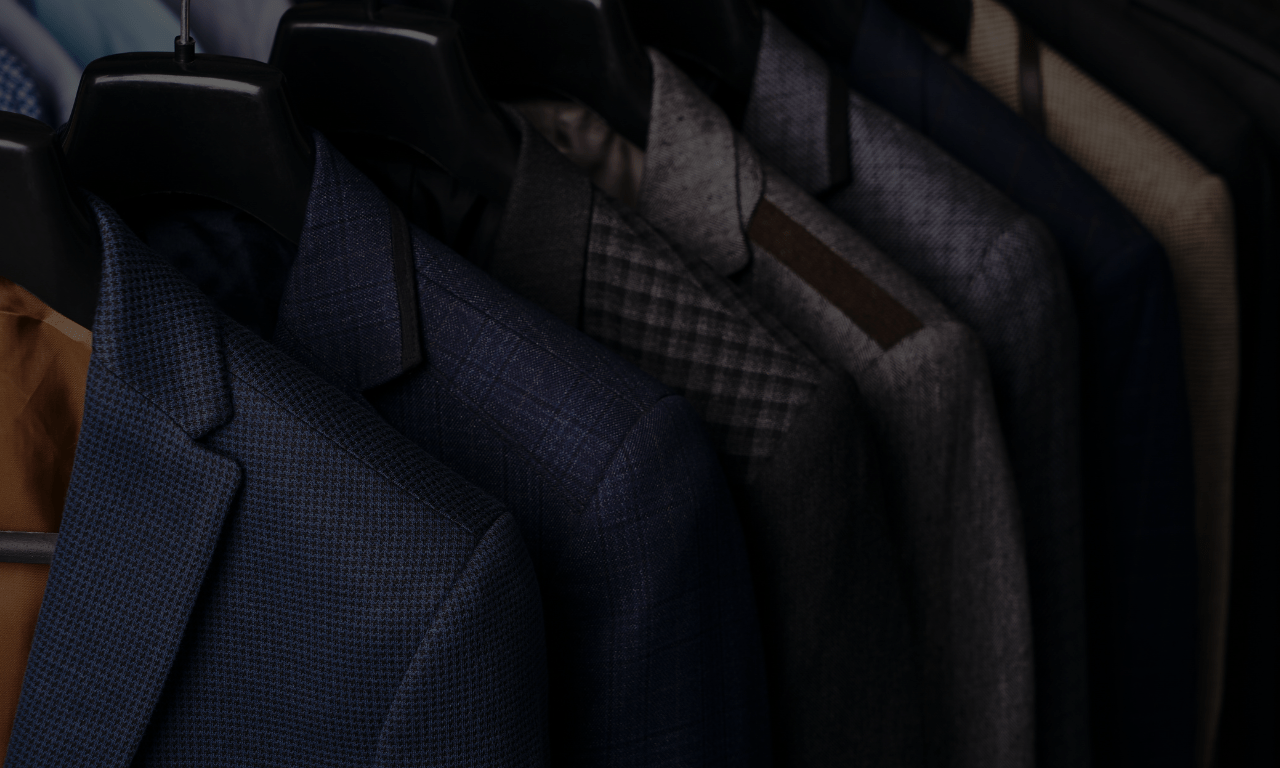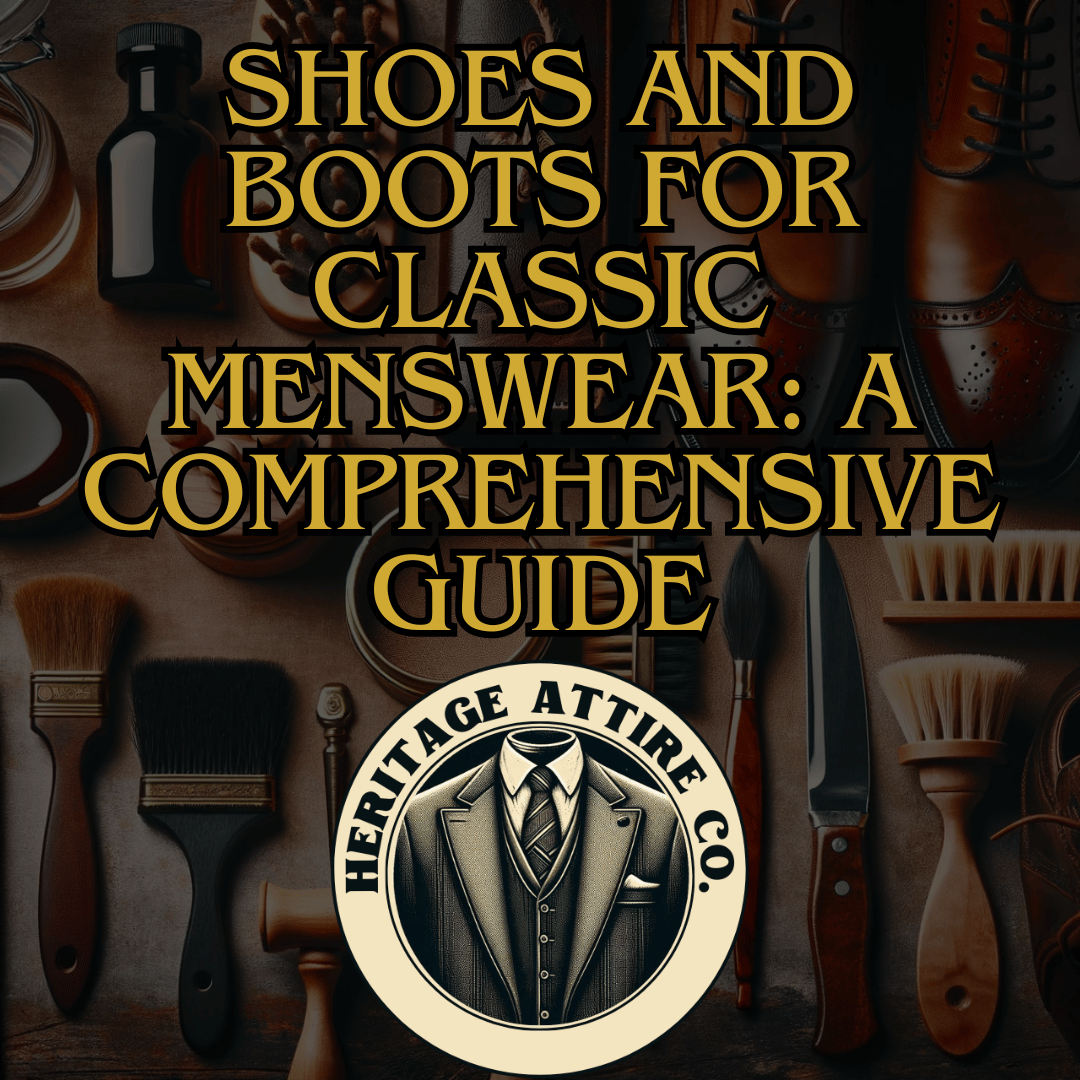Table of Contents
Introduction
Ah, gentlemen! The world of classic menswear is a labyrinth of style and sophistication, and at the heart of this sartorial maze lies the cornerstone of any outfit: the shoes. They say a man’s shoes speak volumes before he utters a word; let’s ensure yours narrate a tale of elegance and class. By the end, you’ll have a clear understanding of what to look for when choosing shoes for your classic menswear wardrobe.
Read our: Timeless Style 101: A Classic Menswear Guide

The Oxford: The Quintessential Gentleman’s Choice
History and Style: The Oxford shoe, with its sleek design and understated grace, is the epitome of men’s footwear. Originating from Scotland and Ireland, this style was popularized by the students at Oxford University in the 1800s. Its key feature? The Balmoral lacing system — a closed-throat style of lacing that offers a snug fit and a streamlined silhouette.
Design Varieties: The Oxford comes in various avatars – the cap toe, the plain toe, and an array of brogueing patterns. Brogueing, initially a practical design to allow water to drain from shoes worn in the wet Highlands, has now become a detail signifying craftsmanship and flair.
The Derby: A Story of Practical Elegance

A Brief History: The Derby, also known as the Gibson or the Blucher, traces its origins back to the 1850s. Named after the 12th Earl of Derby, these shoes were initially designed for comfort and ease of use. The Earl, having wider feet, needed a shoe that was easier to put on, and thus the Derby, with its open lacing system, was born.
Design and Versatility: The defining feature of the Derby is the lacing system where the eyelet tabs are sewn on top of the vamp, offering a more flexible fit. This design element makes the Derby an excellent choice for gentlemen with high insteps or broader feet. Though less formal than the Oxford, the Derby holds its own in versatility, adeptly straddling the line between smart casual and semi-formal attire.
The World Beyond Oxfords: A Shoe Spectrum
Diverse Brogueing and Beyond: Brogue shoes, once the footwear of the Scottish working man, have ascended the ranks of fashion. From full brogues with their wingtip design to semi and quarter brogues with subtle perforations, they bring versatility to your wardrobe.
The Chelsea Boot: Stepping into the world of boots, the Chelsea boot stands out with its ankle-high, laceless design. Dating back to the Victorian era and popularized by the Beatles in the 1960s, it’s the perfect blend of comfort and style. Its elastic side panel and pull-on loop spell convenience and class.
Other Classic Boots: For those who tread the path less taken, other boot options include the stalwart Chukka boot and the dapper Jodhpur boot, each with a distinct character and history rooted in practicality and elegance.
The 6 Pillars of a Gent’s Shoe Collection
When it comes to classic menswear, understanding the level of formality associated with different types of shoes is crucial. The formality of shoes is often measured on a star level, with five stars representing the highest level of formality. For a formal occasion, such as a black-tie event, oxford shoes or dress boots with a goodyear welt construction are the perfect choice.
1. The Classic Oxford: Formality Rating: ⭐⭐⭐⭐⭐
Perfect for business and formal events, the Oxford is non-negotiable for the refined man.
2. The Versatile Brogue: Formality Rating: ⭐⭐⭐⭐
Ideal for semi-formal and smart casual occasions, brogues add personality to your outfit.
3. The Adaptable Derby: Formality Rating: ⭐⭐⭐⭐
With a slightly more relaxed demeanor than the Oxford, the Derby shoe is perfect for a range of occasions, from office wear to casual gatherings.
4. The Suave Loafer: Formality Rating: ⭐⭐⭐
Loafers are your go-to for smart casual events, exuding a relaxed yet sophisticated vibe.
5. The Dapper Chelsea Boot: Formality Rating: ⭐⭐⭐⭐
Equally at home in semi-formal settings and casual outings, these boots are a nod to versatility.
6. The Casual Chukka Boot: Formality Rating: ⭐⭐⭐
Perfect for casual wear, Chukka boots offer comfort without compromising on style.
In conclusion, a well-curated shoe collection is the foundation of a gentleman’s wardrobe. Each pair, a testament to history, craftsmanship, and personal style, plays its part in crafting your sartorial narrative. Choose wisely, gents, for as the right pair of shoes can elevate an outfit, the wrong pair can just as easily undermine it. Remember, in the realm of classic menswear, your shoes are not just a detail; they’re a statement.
The construction of shoes plays a significant role in their durability, comfort, and overall quality. There are three common construction methods: blake stitch, bonded, and goodyear welt.
Read more: The Essentials: Top 5 Shoes Every Canadian Man Needs for Cool Classic Style
Construction Methods
Blake Stitch
The blake stitch construction method involves stitching the upper directly to the sole, providing a sleek and flexible shoe. While blake stitched shoes are generally more affordable, they may lack the durability and water resistance of other construction methods.
Bonded
Bonded shoes are made by gluing together layers of material, typically leather or synthetic, to create the upper. While these shoes are often inexpensive, they tend to have a shorter lifespan and may not be as comfortable or breathable as other options.
Goodyear Welt
The goodyear welt construction method is considered the gold standard for high-quality footwear. It involves stitching the upper, insole, and welt together, creating a sturdy and durable shoe. Goodyear welted shoes are known for their longevity, ease of repair, and ability to mold to the wearer’s foot over time.
Pros and Cons of Different Construction Methods
| Construction Method | Pros | Cons |
|---|---|---|
| Blake Stitch | Sleek design, flexibility | Less durable, limited water resistance |
| Bonded | Inexpensive | Shorter lifespan, less comfortable |
| Goodyear Welt | Long-lasting, easy to repair | Higher cost |
Based on these factors, it is recommended to avoid bonded shoes and often opt for the goodyear welt construction method for its superior quality and longevity.
Materials
The material of your shoes not only affects their appearance but also their durability and comfort. There are several types of leather commonly used in shoe production, each with its own characteristics.
Full Grain Leather
Full grain leather is the highest quality leather available. It comes from the top layer of the hide, retaining its natural texture and markings. This type of leather is known for its durability, breathability, and ability to develop a beautiful patina over time.
Top Grain Leather
Top grain leather is the second-highest quality leather. It is sanded and treated to remove any imperfections, resulting in a smoother and more uniform appearance. While it may not develop the same patina as full grain leather, it still offers excellent durability and comfort.
Suede and Nubuck
Suede and nubuck are types of leather with a soft and velvety texture. They are made from the inner layer of the hide and are known for their luxurious feel. However, they are more susceptible to stains and require regular maintenance to keep them looking their best.
Bonded Leather and Genuine Leather
Bonded leather is made by combining leftover leather scraps with a bonding agent. It is the lowest quality leather and lacks the durability and natural characteristics of full grain or top grain leather. Genuine leather, on the other hand, is a broad term that can refer to any type of leather. It is often used as a marketing term and may not necessarily indicate high quality.
Given the quality and longevity factors, it is highly recommended to opt for full grain leather and completely avoid bonded leather or other plastic considerations.
Shoe and Boot Maintenance: Preserving Your Footwear Legacy
Now, let’s delve into the world of shoe and boot maintenance, a realm where care and attention can extend the life and enhance the beauty of your footwear.
The Art of Shoe Polish
A Historical Glimpse: The history of shoe polish is intertwined with the evolution of footwear itself. Originally, natural substances like wax and tallow were used to condition and waterproof leather. The modern shoe polish, as we know it, emerged in the 20th century, offering both protection and a glossy finish.
Benefits and Application: Shoe polish does more than just make your shoes shine. It nourishes the leather, extends its life, and protects it from elements. When applying, use a soft cloth or a brush, and work the polish in a circular motion, allowing it to penetrate the leather.
Shoe Trees: More Than Just Shapers
Material Matters: The most recommended material for shoe trees is cedar. Why cedar, you ask? It’s because cedar wood not only helps maintain the shape of the shoe but also absorbs moisture and odors, keeping the shoes fresh.
A Nod to History: The use of shoe trees dates back centuries, evolving from simple foot-shaped blocks to adjustable forms that we use today.
Conditioners and Cleaners: The Saviors of Leather
Conditioners: These are vital in keeping the leather supple and preventing it from drying and cracking. A good quality leather conditioner should be used periodically, especially in dry conditions.
Cleaners: Before conditioning or polishing, cleaning the shoes is crucial. Use a quality cleaner that removes dirt and buildup without damaging the leather.
The Humble Shoe Horn
A Tool of Tradition: The shoe horn has a simple yet vital role — it protects the heel counter of your shoe while you put it on. Historically made from animal horn, today’s shoe horns come in various materials but serve the same purpose.
Maintenance Tips and Tricks
- Regular Care: Routine maintenance is key. Don’t wait for your shoes to look worn out before caring for them.
- Alternate Your Shoes: Give your shoes a rest between wears. This allows them to air out and maintain their shape.
- Moisture and Sunlight: Avoid exposing your shoes to excessive moisture and direct sunlight, as they can damage the leather.
- Professional Help: For significant repairs or deep conditioning, don’t hesitate to seek professional services.
In conclusion, the maintenance of your shoes and boots is as crucial as their selection. Proper care will not only enhance their appearance but will also affirm their place in your wardrobe for years to come. Remember, every step in maintaining your footwear is a step towards preserving a legacy of style and quality.
Conclusion
Choosing the right shoes for classic menswear is an art that combines history, construction methods, and materials. By understanding the level of formality, construction methods, and materials used, you can make an informed decision that not only enhances your style but also ensures long-lasting comfort and durability. Remember, investing in high-quality shoes will pay off in the long run, both in terms of aesthetics and value.


